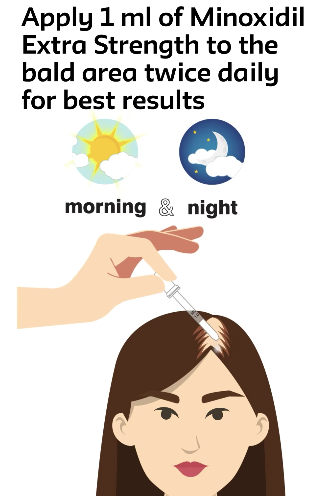
This FDA-approved treatment helps promote hair regrowth and slows the progression of thinning hair, especially in androgenetic alopecia (male and female pattern baldness).
However, choosing the right minoxidil product can be overwhelming, as several formulations are available on the market. To make an informed decision, it’s essential to understand the different types of minoxidil products, how they work, and which suits your needs.
Understanding the Different Minoxidil Forms
Minoxidil comes in various formulations, each designed to cater to different preferences and application needs. The two most common types of minoxidil products are liquid solutions and foam. Both types contain the same active ingredient but differ in application methods, convenience, and user experience.
Liquid Solution
The liquid minoxidil solution is the most traditional form and is often the first choice for many users. It comes in a dropper bottle, which you apply directly to the scalp. The liquid formula is more affordable than foam and has been used successfully for decades to treat hair loss.
One advantage of the liquid solution is its ability to target specific areas of hair thinning, making it ideal for smaller or localized patches of hair loss. The dropper allows precise application, which can be especially useful if you have only mild thinning in certain spots. However, the liquid can sometimes drip or run, making applying messier, especially if you have long hair.
Foam
Instead of using a dropper, you apply the foam directly to the scalp, and it spreads more quickly than the liquid. Many users prefer the foam because it absorbs quickly, dries faster, and is less likely to drip or cause a mess. It’s also generally less irritating to the scalp than the liquid, making it a preferred option for individuals with sensitive skin.
One significant benefit of foam is that it’s typically easier to apply to large areas of the scalp, such as the crown or the top of the head. Foam is also less greasy and often feels lighter on the scalp, which some people find more comfortable for everyday use. However, it may be slightly more expensive than the liquid version, which could be a consideration for users looking for a more budget-friendly option.
Consider Your Hair Type and Application Preferences
If you have long hair, the liquid solution may be a bit cumbersome, as it may require more time to apply thoroughly and evenly. Foam might be a better option because it is easier to distribute across the scalp and doesn’t tend to get tangled in hair.
The liquid form could work just as well for individuals with short hair or smaller areas of thinning, and its precise application might be advantageous in these cases. On the other hand, if you have a busy lifestyle and want something quick to apply with minimal fuss, foam might be the best choice.
Concentration of Minoxidil
The 5% concentration is generally more effective and is recommended for men, while the 2% solution is typically used for women.
For men, the 5% solution has been shown to provide faster and more noticeable results, especially for those dealing with moderate to severe hair loss. Research has demonstrated that a higher concentration of minoxidil can help stimulate hair regrowth “https://generichealth.com.au/minoxidil-hair-loss/” more effectively and may provide better results for individuals with larger areas of thinning or baldness.
Women, however, are usually advised to start with the 2% solution, as it is less likely to cause side effects such as scalp irritation or unwanted facial hair growth. While the 5% concentration is available for women, it’s essential to use it under the guidance of a healthcare provider to avoid potential complications.
Suppose you are just starting treatment and are unsure which concentration is right for you. In that case, it may be helpful to consult with a dermatologist to determine the most appropriate option based on your hair loss pattern and the severity of the condition.
Consider Any Allergies or Sensitivities
When using minoxidil, some individuals may experience scalp irritation, dryness, itching, or redness. In rare cases, people may develop allergic reactions to minoxidil or other ingredients in the formulation. If you experience severe redness, swelling, dizziness, or a rash, discontinue use and consult a doctor immediately. It’s also a good idea to perform a patch test before using minoxidil regularly to ensure you don’t have an adverse reaction.
Price and Budget Considerations
Minoxidil products vary in price, with the foam typically being more expensive than the liquid. Since hair loss treatments often require long-term use to see results, cost can become a factor for many individuals. When selecting a minoxidil product, it’s essential to consider how long you are willing to commit to using it and how much you are willing to spend.
If budget is a concern, the liquid solution may offer a more affordable option, especially if you can use it effectively with precise application. On the other hand, if you are willing to invest a little more for the convenience and ease of use provided by the foam, it may be worth the extra cost, especially if it encourages consistency in your treatment routine.
Long-Term Commitment and Results
Whichever minoxidil product you choose, remember that hair regrowth takes time. Most users begin to see results within two to four months of consistent use, but it can take up to a year to experience the full benefits.
Consistency is critical, regardless of the product you choose. Applying minoxidil regularly—at least twice daily—is essential for achieving the best results. Missing applications can slow progress, so making it a part of your daily routine is necessary.
Conclusion
Choosing the right minoxidil product depends on several factors, including your hair type, application preferences, and any sensitivities you may have. Both liquid and foam formulations have their benefits, and selecting the right one comes down to personal preference and convenience. Concentration strength, skin sensitivity, and budget will also play essential roles in your decision-making process.